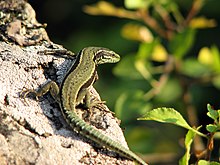Claw

A claw is a curved, pointed appendage found at the end of a toe or finger in most
A true claw is made of a hard
Similar appendages that are flat and do not come to a sharp point are called nails instead. Claw-like projections that do not form at the end of digits but spring from other parts of the foot are properly named spurs.[1]
Tetrapods
In tetrapods, claws are made of keratin and consist of two layers. The unguis is the harder external layer, which consists of keratin fibers arranged perpendicular to the direction of growth and in layers at an oblique angle. The subunguis is the softer, flaky underside layer whose grain is parallel to the direction of growth. The claw grows outward from the nail matrix at the base of the unguis and the subunguis grows thicker while travelling across the nail bed. The unguis grows outward faster than the subunguis to produce a curve and the thinner sides of the claw wear away faster than their thicker middle, producing a more or less sharp point. Tetrapods use their claws in many ways, commonly to grasp or kill prey, to dig and to climb and hang.
Mammals

All
Most cats and dogs also have a dewclaw on the inside of the front paws. It is much less functional than the other claws but does help the cats to grasp prey. Because the dew claw does not touch the ground, it receives less wear and tends to be sharper and longer.
A
Every so often, the growth of claws stops and restarts, as does hair. In a hair, this results in the hair falling out and being replaced by a new one. In claws, this results in an abscission layer, and the old segment breaks off. This process takes several months for human thumbnails. Cats are often seen working old unguis layers off on wood or on boards made for the purpose. Ungulates' hooves wear or self-trim by ground contact. Domesticated equids (horses, donkeys and mules) usually need regular trimming by a farrier, as a consequence of reduced activity on hard ground.
Primates
Reptiles


Most reptiles have well-developed claws. Most lizards have toes ending in stout claws.[5] In snakes, feet and claws are absent, but in many boids such as Boa constrictor, remnants of highly reduced hind-limbs emerge with a single claw as "spurs" on each side of the anal opening.
Lizard claws are used as aids in climbing, and in holding down prey in carnivorous species.
Birds
A talon is the claw of a bird of prey, its primary hunting tool.[6] The talons are very important; without them, most birds of prey would not be able to catch their food. Some birds also use claws for defensive purposes. Cassowaries use claws on their inner toe (digit I) for defence and have been known to disembowel people.[7][8] All birds, however, have claws, which are used as general holdfasts and protection for the tip of the digits.
The
Amphibians
The only
Arthropods

The scientifically correct term for the "claw" of an arthropod, such as a lobster or crab, is a
See also
References
- ^ Rand, A.L. (1954). "On the Spurs on Birds' Wings" (PDF). The Wilson Bulletin. 66 (2): 127–134. Retrieved 16 November 2012.
- ISBN 978-0-231-10228-5.
- PMID 9924135.
- PMID 22042603.
- .
- PMID 19946365.)
{{cite journal}}: CS1 maint: multiple names: authors list (link - PMID 3314103.
- ISSN 1098-2361.
- S2CID 1296408. Archived from the original(PDF) on 2017-07-09. Retrieved 2016-07-08.
- .
- Walter Lawry Buller (1888): A History of the Birds of New Zealand. London excerptfrom Zealand Electronic Text Centre collection.
- PMID 19422431.
External links
- Rat's Claws, also explains much about mammalian claws in general.
